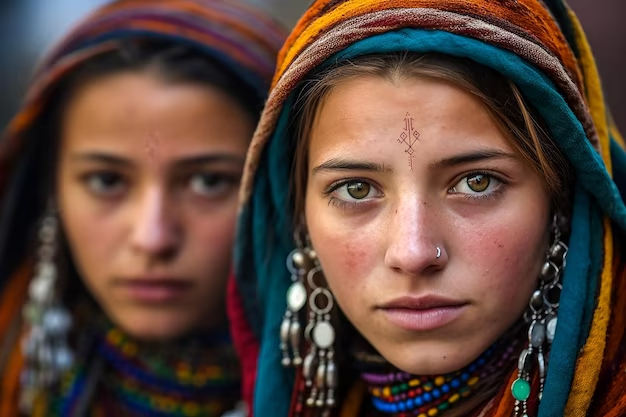
Introduction: Tracing the Ancient Roots of Amaziğ Culture
The Amaziğ subculture, also known as the Berber lifestyle, is a vibrant tapestry woven into the rich records of North Africa. Its roots stretch back millennia, shaping the location’s identity and leaving an indelible mark on its cultural panorama. From ancient traditions to present-day expressions, the legacy of this culture holds profound significance, both for those familiar with it and for the wider knowledge of North African background.
The Rise of Amaziğ Civilization: Flourishing Amidst North Africa’s Landscape
The Berber (another term often used interchangeably with Amaziğ to refer to the indigenous people and culture of North Africa) civilization emerged in the rugged terrain of North Africa, adapting to various environments ranging from the Atlas Mountains to the arid expanses of the Sahara Desert. Despite the demanding situations posed by harsh climates and nomadic life, North African Cultural communities thrived, building rich societies founded on resilience and resourcefulness. Their deep connection to the land fostered a profound appreciation for nature, which permeates the berber lifestyle to this day.
Resilience in Adversity: How Amaziğ Culture Survived and Thrived Through History
Throughout history, North African people’s way of life has weathered limitless storms, from overseas invasions to colonial rule. Yet, in the face of adversity, the spirit of these poeple remained unbroken. Drawing energy from their ancestral traditions and collective identity, they preserved their cultural heritage, adapting to changing instances while safeguarding their values and customs. This resilience is a testimony to the enduring legacy of Berber subculture.
Traditions Passed Down: Exploring the Rituals and Customs of Amaziğ Society
At the coronary heart of Berber society is its rich tapestry of traditions and customs, which have evolved from technology to era. From problematic ceremonies to day-to-day practices, these rituals are the cornerstone of this North African culture identification, binding groups together and reinforcing their sense of belonging. Whether celebrating lifestyle milestones or honoring their ancestors, Berber traditions offer a feeling of continuity and connection to the past.
The Language of Amaziğ:Preserving an Ancient Tongue in a Modern World
One of the most exclusive components of Berber way of life is its language, which boasts a wealthy linguistic background relationship returned hundreds of years. Despite centuries of out-of-door influence, the Amaziğ language has persevered, serving as an image of cultural pride and resilience. Efforts to maintain and promote the Amaziğ language have received momentum in current years, with tasks aimed at revitalizing its usage in schooling, media, and everyday lifestyles.

Architecture and Art: Showcasing the Aesthetic Brilliance of Amaziğ Heritage
The architectural and artistic traditions of the people of North African culture are a testament to their ingenuity and creativity. From the dust-brick kasbahs of Morocco to the cave dwellings of the Mzab Valley, Berber structures reflect a deep knowledge of local substances and environmental situations. Similarly, Amaziğ artwork features a wide array of paperwork, including complicated textiles, colorful ceramics, and symbolic earrings, each telling a story of cultural identification and expression.
Nomadic Nomads to Urban Dwellers: Adapting to Changing Times
Amaziğ communities have undergone enormous changes in recent centuries, transitioning from nomadic existence to settled urban dwellings. This shift has created possibilities and demanding situations as conventional approaches to life intersect with modernization and globalization. Yet, regardless of these adjustments, the resilience of the Berber lifestyle endures as groups find new ways to hold their history while embracing the opportunities of the cutting-edge world.
Festivals and Celebrations: The Vibrant Tapestry of Amaziğ Cultural Events
Throughout the year, North African Cultural communities come collectively to have fun with their cultural heritage via vibrant festivals and celebrations. These occasions, regularly marked via music, dance, and feasting, serve as a time-commemorated communal bonding and expression tradition. From the colorful festivities of the Imilchil Marriage Festival to the spiritual pilgrimage of the Moulay Idriss Festival, Amaziğ celebrations replicate the variety and richness in their cultural identification.
The Role of Women: Empowerment and Equality in Amaziğ Society
In this culture, women play a primary role in shaping network life and retaining cultural traditions. Historically, women were custodians of oral records, transmitting information and values from one technology to the next. Today, women continue to contribute to all elements of Amaziğ society, from agriculture and artisanal crafts to training and politics, empowering future generations to carry forward the legacy of their ancestors.

Amaziğ Cuisine: A Culinary Journey Through North African Flavors
The culinary traditions of North African culture are as diverse because of the landscapes they inhabit, presenting a tantalizing journey through North African flavors. From hearty tagines simmered with fragrant spices to delicate pastries full of honey and nuts, This Cultural delicacies reflect the bounty of the land and the ingenuity of its human beings. Whether savoring a traditional couscous or indulging in a candy mint tea, each meal is an opportunity to experience the hospitality and warmth of Amaziğ culture.
Contemporary Influences: How Amaziğ Culture Continues to Shape North Africa
In today’s rapidly changing global, This tradition continues to conform and adapt, influencing the cultural landscape of North Africa and beyond. From song and literature to style and cinema, Amaziğ artists and creators are making their mark worldwide, showcasing the richness and variety of their heritage. The Berber lifestyle stays a vibrant and dynamic force within the cutting-edge international through innovative collaborations and cross-cultural exchanges.
Education and Preservation: Efforts to Safeguard Amaziğ Heritage for Future Generations
Recognizing the significance of preserving Amaziğ history for future generations, efforts are underway to report, defend, and sell its cultural legacy. From network-led initiatives to government-backed applications, stakeholders work together to guard Amaziğ language, traditions, and ancient websites. Through education and outreach, those efforts aim to instill pride and ownership among Amaziğ children, ensuring that their cultural heritage continues to thrive in the years to come.
Global Recognition:Amaziğ Culture at the World Stage
In recent years, Amaziğ culture has been popular in the sector degree, with UNESCO designating numerous websites and practices as Intangible Cultural Heritage. From the historical rock art of Tassili n’Ajjer to the traditional track of Gnawa, those cultural treasures function as ambassadors of berber heritage, attracting traffic worldwide. Through worldwide collaborations and cultural exchanges, This tradition is gaining visibility and appreciation on a global scale, enriching the tapestry of human range and understanding.
Modern Challenges: Balancing Preservation with Progress in Amaziğ Communities
Despite the resilience of berber tradition, communities face numerous challenges in retaining their history in the cutting-edge world. Rapid urbanization, environmental degradation, and socio-economic disparities threaten conventional life methods, forcing groups to choose between protection and progress. Balancing the desire for sustainable improvement with the safety of cultural identification is an ongoing conflict for North African Cultural communities, requiring progressive solutions and collaborative partnerships to ensure a colorful and resilient destiny.

Conclusion:Reflecting on the Enduring Legacy and Future Prospects of Amaziğ Culture
One element is transparent as we reflect on the iconic legacy and future potentialities of the Amaziğ lifestyle: its importance transcends time and borders. From historic roots to trendy reverence, the legacy of this tradition continues to enhance and inspire generations to return. Through its traditions, language, artwork, and delicacies, this culture embodies the resilience, creativity, and variety of North Africa, forging a route closer to a destiny wherein the historical past is widely known and loved.
FAQs:
Addressing Common Questions About this Culture
What is the significance of Amaziğ tradition in North Africa?
This Culture’s lifestyle is deeply rooted in North Africa’s history and identity. It represents the location’s indigenous heritage and serves as a source of delight and identification for its people.
How has the Amaziğ subculture advanced over the years?
This culture has evolved via centuries of interactions with various civilizations and cultures. While keeping its center values and traditions, it has additionally tailored to changing instances, demonstrating resilience and versatility.
What are some commonplace misconceptions about Amaziğ subculture?
One common misconception is that this tradition is static and unchanging. It’s a dynamic and colorful culture that has developed over the years while maintaining its excellent identification.
How can one experience this culture tradition firsthand?
Traveling to North Africa, touring berber groups, attending cultural festivals, and collaborating with nearby customs and traditions are excellent ways to enjoy this tradition firsthand.
What are the origins of the Amaziğ human beings?
These people are indigenous to North Africa and have a history dating back many years. Their origins can be traced to the indigenous populations of the region, who have inhabited the region for centuries.
Do other civilizations inspire Amaziğ subculture?
Yes, this culture has been prompted by the aid of various civilizations that have interacted with North Africa over the centuries. These encompass the Phoenicians, Romans, Arabs, and French. However, berber way of life has also retained its excellent identification and traditions.
What are a few key cultural symbols in this society?
Some key cultural symbols in Amaziğ society encompass the Amazigh flag, which features the letter “Z” for “Amaziğ” in Tifinagh’s script, and this cultural emblem, which regularly depicts the solar, stars, or other herbal factors.
How do these groups have fun weddings and different life occasions?
Amaziğ groups have fun weddings and other lifestyle activities, with tricky ceremonies and rituals that change depending on the place and the community’s specific traditions. These celebrations regularly involve music, dancing, feasting, and conventional apparel.
What function does storytelling play in Amaziğ lifestyle?
Storytelling is a valuable aspect of berber way of life, with oral traditions passed down through generations. Storytellers, called “imedyazen” recount stories of heroes, myths, and historical events, preserving the collective memory of the network.
Are there extraordinary dialects of the Amaziğ language?
Several dialects of the Amaziğ language are spoken throughout North Africa, reflecting the region’s linguistic variety. These dialects can vary extensively in pronunciation, vocabulary, and grammar; however, they are all part of the wider Amaziğ language circle of relatives.
What are a few conventional occupations in this society?
Traditional occupations in the North African cultural society include farming, herding, artisanal crafts, and change. These occupations are often carefully tied to the local environment and cultural practices, reflecting the sustainable existence of these groups.
How do thesee groups preserve their cultural heritage?
North African Cultural communities maintain their cultural background in numerous ways, including oral traditions, galas, instructional packages, and cultural establishments. Efforts are also underway to report and digitize cultural artifacts and historic sites for future generations.
What role do ladies play in this society?
Women play various and crucial roles in Amaziğ society, including as caretakers, educators, artisans, and community leaders. While gender roles may vary depending on the precise traditions of every network, girls are valued for their contributions to their family life, cultural renovation, and economic sustainability.
How can people guide berber cultural preservation efforts?
Individuals can aid Amaziğ cultural upkeep efforts by learning about this subculture, respecting its traditions and customs, supporting local artisans and cultural projects, and advocating for the recognition and safety of Amaziğ historical past at neighborhood and global levels.






